Dual Yellow Laser
That the term ‘Laser’ is an acronym? It stands for light amplification by the stimulated emission of radiation. Lasers are sources of high intensity light with the following properties:
- Monochromatic i.e. the light is of a single wavelength
- Coherent i.e. the light beam waves are in phase
- Collimated i.e. the light beams travel in parallel
Laser light can accurately focused into small spots with very high energy. The light is produced within an optical cavity containing a medium, which may be a gas, liquid or solid. Each medium produces a specific wavelength of light, which may be within the visible spectrum (violet 400 through to red 700nm) or infrared spectrum (more than 700 nm).
Vascular skin lesions contain oxygenated haemoglobin, which strongly absorbs visible light at 418, 542 and 577 nm, whereas pigmented skin lesions contain melanin, which has a broad range of absorption in the visible and infrared wavebands.
The aim is to destroy the target cells and not to harm the surrounding tissue. Short pulses reduce the amount that the damaged cells heat up, thereby reducing thermal injury that could result in scarring.
Skin Doctor SA uses the “Dual Yellow” Laser, so called because it emits light with two peak emissions, at wavelengths 511 (green) and 578 nm (yellow).
Vascular Lesions
The yellow light is used very effectively to treat vascular lesions (red)
- Facial telangiectasia and small red facial veins (spider veins)
- Spider angiomas
- Cherry angiomas
- Small port wine stains
- Rosacea
Treated vascular lesions blanch when exposed to the yellow light. A a single session rarely exceeds 30 minutes, depending on the extent of the skin problem. The treated skin appears red for a few hours. The following day there may be localised swelling and on occasions crusting. Eyelid swelling occasionally occurs but rarely lasts more than a few days.
Telangiectasia, Spider Naevi, Spider Veins and Broken Capillaries
Naevi and broken capillaries represent dilated surface blood vessels, otherwise known as telangiectasia which are dilated surface blood vessels. Telangiectasia are usually seen on the face (nose, cheeks and chin) and on the legs, particularly the lower part of the leg. Telangiectasia are usually benign but are for some unsightly and distressing. Telangiectasia generally respond well to laser treatment.

Before After
Cherry Angiomas
Cherry angiomas are very common small cherry-red lumps usually the size of a pin head which may grow slowly to the size of a match head. In contrast to pyogenic glanulomas they rarely cause discomfort and only require treatment for cosmetic reasons. They respond well to laser treatment.
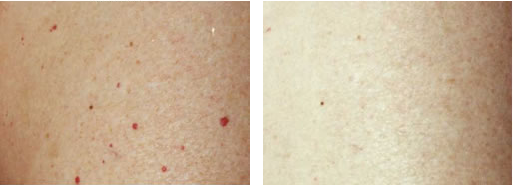
Before After
Rosacea
Rosacea is a common disorder, causing a red facial rash affecting the cheeks and nose mostly, but also often the chin and lower forehead area.
The cause of rosacea is unknown. It may develop at any age, in either sex but most often begins in women between 30 and 50 years of age. In men, rosacea tends to begin earlier and to be more severe.
Factors which cause flushing in normal people may aggravate rosacea and make it more apparent but there is no evidence that these factors are involved in causing the disorder.
The facial redness is caused by a combination of prominent blood vessels (telangiectasia) and background redness (erythema). In many cases there is also an eruption of acne-like lumps within the area of facial redness.
Rosacea can be treated successfully or greatly improved by Laser and IPL (Intense Pulsed Light) treatments, often in association with oral or topical treatments.
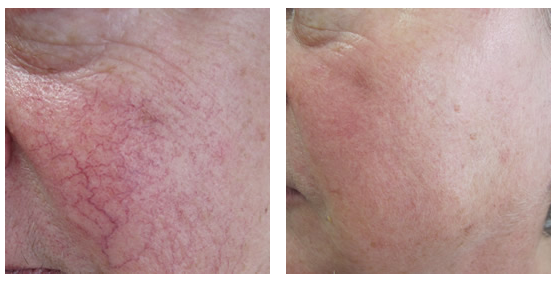
Before After
Port Wine Stains
Port wine stains are vascular birthmarks due to patches of capillary vascular malformations. Some may fade over time but most remain unchanged.
Most port wine stains can be improved and sometimes removed by laser treatment, although numerous treatments are usually required.
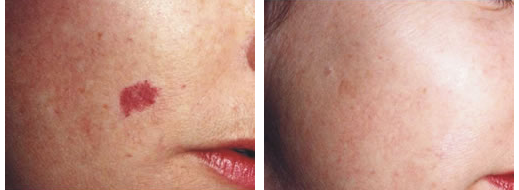
Before After
Pyogenic granulomas
Pyogenic granulomas, also referred to as a granuloma telangiectaticum, are small vascular malformations. Pyognic granulomas appear as cherry-red, shiny lumps which may grow very rapidly from the size of a pin-head size to that of a small pea. Pyogenic granulomas, usually form on the trunk, arms or legs and can cause discomfort and bleeding. They respond well to laser treatment, but caution needs to be exercised to eliminate other conditions, especially skin cancers. Quite often the lesion needs to be biopsied or excised for histology testing to be sure it is benign.
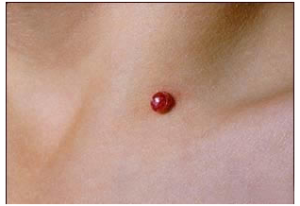
Bulk Lesions
Combined yellow and green light is sometimes used to treat “bulk” surface skin lesions as an alternative to cryotherapy (freezing) or surgery.
- Seborrhoeic keratoses
- Solar keratoses
- Skin tags
- Warts
- Benign moles
As well as being ideal for the treatment of individual, discrete vascular and pigmented lesions, the Dual Yellow Laser, used at Skin Doctor SA, also has a unique contact scanner which uses a combination of light for skin tightening reducing large pores, fine lines and wrinkles while freshening up the tone and texture of the skin. These treatments can be achieved in a single lunch break with very minimal side effects and makeup can be worn straight after.
At Skin Doctor SA in Semaphore the selection of light colour and hand piece will be decided by clinical staff depending on the type of blemish or the area of skin being treated.
The clinical staff at Skin Doctor SA are medically trained and are certified for safe use of laser and IPL equipment.
Points to note:
- Avoid sun exposure in the days and weeks before and after treatment.
- A topical anaesthetic may be applied to the area but is usually not necessary.
- The smooth glass surface of the IPL treatment head is applied to the skin, delivering precise pulses of light top the area being treated.
- Treatment sessions usually last 5-20 minutes, depending on the area to be treated.
- Most clients can return to work immediately after treatment.
Are there any side effects?
Side effects are minor but may include:
- Pain during treatment (reduced by contact cooling)
- Skin turning pink and a little sore immediately after the procedure.
- Sensation of a mild sunburn (redness, peeling, swelling) that may last a few days after treatment.
- Rarely, skin pigment may absorb too much light energy and blistering can occur.
- Sometimes the pigment cells (melanocytes) can be damaged leaving darker or paler patches of skin. White patches or scars are rarely permanent.
- Hair loss may occur in the treated area.
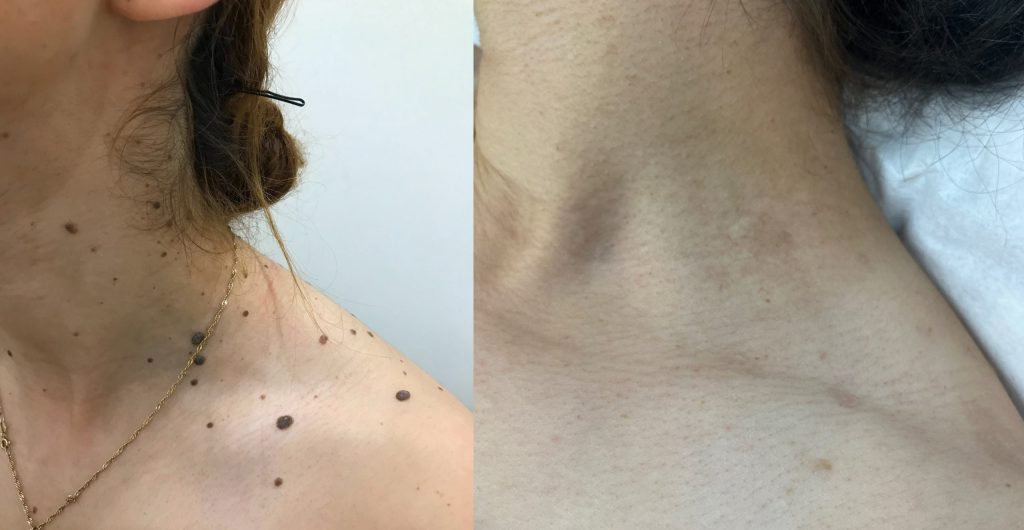
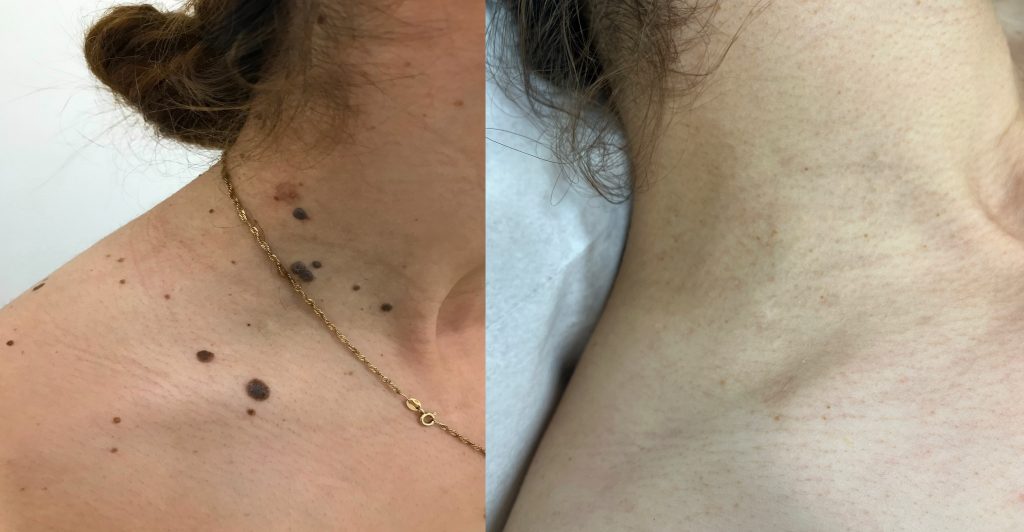
Before
After
Before
After
IPL (Intense Pulsed Light)
Intense pulsed light (IPL) is a non-invasive and non-ablative treatment that uses high intensity pulses of visible light to improve the appearance of vascular lesions, pigmented and sun-damaged or ageing skin.
How does it work?
IPL systems work on the same principles as lasers in that light energy is absorbed into particular target cells with colour (chromophores) in the skin. The light energy is converted to heat energy, which causes damage to the specific target area. IPL systems are different from lasers in that they deliver many wavelengths (or colours) in each pulse of light instead of just one wavelength. Most IPL systems use filters to refine the energy output for the treatment of certain areas. This enhances penetration without using excessive energy levels and enables targeting of specific chromophores (the skin components that absorb light).
There is a range of IPL machines. Individual machines may be specially designed to focus on certain problem areas but may not be equally effective on others. We use the Chromolite IPL system, which emits a dual band of yellow and green light which is particularly effective for both hair removal and skin rejuvenation.
Chromolight
IPL therapy is considered a non-ablative resurfacing technique, which means that it targets the lower layers of skin (dermis) without affecting the top layers of skin (epidermis). The results are not as dramatic as ablative resurfacing where both the dermis and the epidermis are injured to produce a much more noticeable overall outcome. The advantage of IPL therapy is requires minimal downtime – a client can often have the procedure done in their lunch break and return to work immediately afterwards.
IPL therapy has a number of uses such as:
- Vascular lesions: For the treatment of areas of erythema (redness) due to vascular proliferation, such as red nose and cheeks in rosacea and sun damaged necks and chests.
- Pigmented lesions: For the treatment of age spots, freckles, flat pigmented birthmarks and other skin discolouration problems such as melasma/chloasma, and erythromelanosis of the neck (poikiloderma of Civatte). Light pulses targeted at the melanin in the skin’s surface heat and destroy melanin to remove the discolouration.
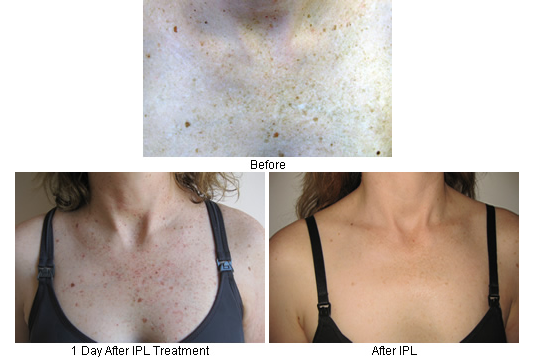
IPL and Skin Rejuvenation
The Chromolite IPL used by our team enables us to perform a skin rejuvenation treatment that will help to soften the visible aspects of all factors; softening lines and wrinkles and tightening skin, reducing pigmentation and vascular conditions.
New collagen is formed in response to the body’s perceived injury to ‘heal’ the wound, whether that is by surgical intervention or traumatic injury. The light from Chromolite penetrates deep into the dermal layer of the skin tissue, heating up the dermal microvasulature and triggering off this ‘healing’ response.
What does the procedure involve?
Prior to the procedure your Skin Doctor SA practitioner will explain the process to you and clearly define your expectations of the treatment. They should be able to tell you whether or not the results you are looking for will be achievable using this method. It is important that the correct diagnosis has been made prior to the treatment.
Points to note:
- Avoid sun exposure in the days and weeks before and after treatment
- A topical anaesthetic may be applied to the area but is usually not necessary.
- Cold gel is applied to the area being treated.
- The smooth glass surface of the IPL treatment head is applied to the skin, delivering precise pulses of light top the area being treated.
- Treatment sessions usually last 5-20 minutes, depending on the area to be treated.
- A course of 4 -6 sessions may be required to achieve desired results.
- Most clients can return to work immediately after treatment.
Are there any side effects?
Any potential side effects are minor but can include:
- Pain during treatment (reduced by contact cooling)
- Skin turning pink and a little sore immediately after the procedure.
- Sensation of a mild sunburn (redness, peeling, swelling) that may last a few days after treatment.
- Rarely, skin pigment may absorb too much light energy and blistering can occur.
- Sometimes the pigment cells (melanocytes) can be damaged leaving darker or paler patches of skin. White patches or scars are rarely permanent.
- Hair loss may occur.
